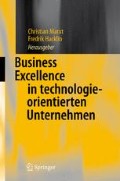Abstract
Aufgrund des wachsenden Drucks auf die Produktionskosten von Pharmazeutischen Unternehmen gewinnt das Thema Operative Exzellenz zunehmend an Bedeutung. Da dieses Thema im Vergleich zu anderen Industrien – wie beispielsweise der Automobilindustrie oder dem Maschinenbau – in der Pharmaindustrie nahezu stiefmütterlich behandelt wurde, soll der folgende Beitrag Probleme und Ansätze zur Steigerung der Operativen Exzellenz in der Pharmaindustrie aufzeigen. Hierfür wird in Kap. 1 näher abgegrenzt, was unter den Begriffen Operative Exzellenz und Ganzheitliche Produktionssysteme zu verstehen ist. Im Anschluss daran wird die Rolle der Produktion in der pharmazeutischen Industrie näher untersucht. Dies ist von Bedeutung, da im Anschluss daran, ein auf die Pharmaindustrie anwendbares Operatives Exzellenz-Modell vorgestellt wird. Aufbauend darauf wurden Standorte der galenischen Produktion sowie der Wirkstoffherstellung untersucht. Die identifizierten Verbesserungspotenziale werden am Ende dieses Beitrages erläutert.
Access this chapter
Tax calculation will be finalised at checkout
Purchases are for personal use only
Preview
Unable to display preview. Download preview PDF.
Literatur
Bösenberg D und Metzen H (1993): Lean Management. Vorsprung durch schlanke Konzepte. Verlag moderne Industrie, Landsberg/Lech, 1993
Cua KO, McKone KE und Schroeder RG (2001): Relationships between implementation of TQM, JIT, and TPM and manufacturing performance. In: Journal of Operations Management, Vol 19, No 6 SU, 2001, S 675–694
Economist (2002): Trouble in the making. In: Economist, Vol 364, No 8288, 2002, S 49–50
Flynn BB und Sakakibara S (1995): Relationship between JIT and TQM: Practices and performance. In: Academy of Management Journal, Vol 38, No 5, 1995, S 1325–1360
Flynn BB, Schroeder RG und Flynn EJ (1999): World class manufacturing: an investigation of Hayes and Wheelwright’s foundation. In: Journal of Operations Management, Vol 17, No 3 SU, 1999, S 249–269
Giffi C, Roth AV und Seal GM (1990): Competing in World-Class Manufacturing: America’s 21st Century Challenge. Business One Irwin, Homewood, IL, 1990
Hall RW (1987): Attaining Manufacturing Excellence: Just-in-Time, Total Quality, Total People Involvement. Irwin, Homewood, IL, 1987
Hayes RH und Pisano GP (1994): Beyond World-Class: The New Manufacturing Strategy. In: Harvard Business Review, Vol 72, No 1, 1994, S 77–86
Hayes RH, Pisano GP, Upton DM und Wheelwright SC (2005): Operations, Strategy, and Technology: Pursuing the Competitive Edge. Wiley, New York, 2005
Hayes RH und Wheelwright SC (1984): Restoring Our Competitive Edge: Competing Through Manufacturing. Wiley, New York, 1984
Karlsson C und Ahlstrom P (1996): Assessing changes towards lean production. In: International Journal of Operations & Production Management, Vol 16, No 2, 1996, S 24–41
Ketokivi M und Schroeder R (2004): Manufacturing practices, strategic fit and performance A routine-based view. In: International Journal of Operations & Production Management, Vol 24, No 2, 2004, S 171–191
McKone KE, Schroeder RG und Cua KO (2001): The impact of total productive maintenance practices on manufacturing performance. In: Journal of Operations Management, Vol 19, No 1, 2001, S 39–57
McLachlin R (1997): Management initiatives and just-in-time manufacturing. In: Journal of Operations Management, Vol 15, No 4, 1997, S 271–292
Mehra S und Inman RA (1992): Determing the Critical Elements of Just-In-Time Implementation. In: Decision Sciences, Vol 23, No 1, 1992, S 160–174
Ohno T (1988): Toyota Production System: Beyond large scale production. Productivity Press, Cambridge, 1988
Peters T und Waterman RH (1982): In Search of Excellence. Warner Books, New York, 1982
Pilkington A (1998): Manufacturing strategy regained: Evidence for the demise of best-practice. In: California Management Review, Vol 41, No 1, 1998, S 31-42
Pisano G und Günthardt D (2003): Wo sich Hollywood und Detroit treffen. In: NZZ, 11.08.2003
Porter EM (1985): Competitive Advantage: Creating and Sustaining Superior Performance. Macmillan, New York, 1985
Sakakibara S, Flynn BB, Schroeder RG und Morris WT (1997): The impact of Just-In-Time manufacturing and its infrastructure on manufacturing performance. In: Management Science, Vol 43, No 9, 1997, S 1246–1257
Samson D und Terziovski M (1999): The relationship between total quality management practices and operational performance. In: Journal of Operations Management, Vol 17, No 4, 1999, S 393–409
Schonberger RJ (1982): Some Observations on the Advantages and Implementation Issues of Just-in-Time Production Systems. In: Journal of Operations Management, Vol 3, No 1 1982, S 1–11
Schuh G (2002): Referenzstrategien in einer vernetzten Welt, Berlin, 2002
Shah R und Ward PT (2003): Lean manufacturing: context, practice bundles, and performance. In: Journal of Operations Management, Vol 21, No 2, 2003, S 129–149
Skinner W (1969): Manufacturing: Missing Link in Corporate Strategy. In: Harvard Business Review, No May/June, 1969, S 136–145
Spaethe TU (2001): Die Pharmaindustrie und die Biotechnologie: Analyse der Veränderungen in der Industriestruktur. Dissertation Universität Regensburg, Regensburg, 2001
Stalk Jr G und Webber AM (1993): Japan’s dark side of time. In: Harvard Business Review, Vol 71, No 4, 1993, S 93–102
Vocke R und Jäger M (2004): Supply Chain Excellence in der Pharmaindustrie. In: pharmind, Vol 66, No 2, 2004, S 148–155
Wheelwright SC und Hayes RH (1985): Competing through manufacturing. In: Harvard Business Review, Vol 63, No 1, 1985, S 99–109
Womack JP, Jones DT und Roos D (1990): The Machine That Changed the World. Rawson, New York, 1990
Womack JP und Jones DT (1996): Lean thinking: Banish Waste and Create Wealth in Your Corporation, Simon and Schuster, New York, 1996
Author information
Authors and Affiliations
Rights and permissions
Copyright information
© 2008 Springer-Verlag Berlin Heidelberg
About this chapter
Cite this chapter
Friedli, T., Tykal, D., Gronauer, T. (2008). Operative Exzellenz in der Pharmazeutischen Industrie. In: Business Excellence in technologieorientierten Unternehmen. Springer, Berlin, Heidelberg. https://doi.org/10.1007/978-3-540-73881-7_6
Download citation
DOI: https://doi.org/10.1007/978-3-540-73881-7_6
Publisher Name: Springer, Berlin, Heidelberg
Print ISBN: 978-3-540-73880-0
Online ISBN: 978-3-540-73881-7
eBook Packages: Business and Economics (German Language)

